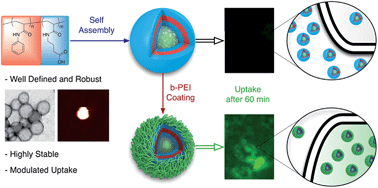Amphiphilic polymers have been synthesised by controlled free radical polymerisation techniques. These polymers self-assemble into well-defined vesicles in aqueous conditions, enabling encapsulation of a model hydrophilic molecule. The polymeric vesicles show high stability against a range of aqueous conditions with marginal release of cargo, even in the presence of known cell-membrane disruptive polymers such as branched poly(ethylene imine) (b-PEI). This stability allows for inversion of the surface charge of the polymeric vesicles by a simple coating protocol leading to an enhanced uptake by mammalian cells.
Well-defined polymeric vesicles with high stability and modulation of cell uptake by a simple coating protocol Gökçen Yaşayan, Martin Redhead, Johannes P. Magnusson, Sebastian G. Spain, Stephanie Allen, Martyn Davies, Cameron Alexander and Francisco Fernández-Trillo Polym. Chem., 2012, 3, 2596-2604.
To keep up-to-date with all the latest research, sign up for the journal’s e-alerts or RSS feeds or follow Polymer Chemistry on Twitter or Facebook.











